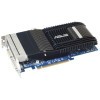- Qualcomm Launches Snapdragon 4 Gen 2 Mobile Platform
- AMD Launches Ryzen PRO 7000 Series Mobile & Desktop Platform
- Intel Launches Sleek Single-Slot Arc Pro A60 Workstation Graphics Card
- NVIDIA Announces Latest Ada Lovelace Additions: GeForce RTX 4060 Ti & RTX 4060
- Maxon Redshift With AMD Radeon GPU Rendering Support Now Available
Content and news by Rob Williams

Rob's Recent Content
NVIDIA to Simplify Their Product Lineup to Help Appeal to Wider Audience
Most of you who visit this site are hardware enthusiasts, and picking out a new GPU, CPU or any other piece of computer hardware is not likely too much of a hassle. But that’s because you know what to look for. You read reviews, like the ones here. You study up on manufacturers websites. You read whitepapers. You know what’s going on. But what about those who are not computer enthusiasts? Picking out hardware can be hell!
NVIDIA released their 9800GTX not too long ago, a top-of-the-line single-GPU offering. But is it better than ATI’s 9800PRO? Exactly, that’s the problem with naming schemes nowadays. The 9800PRO is about five years old, and horribly outdated in GPU lifespan terms, but how’s an uninformed buyer supposed to know? Or how about the sheer amount of different models at a given number range? The 9-series just came out and there are already four different ones, with more en route.
Well thankfully, NVIDIA is looking to change this problem, and not a moment too soon. Their goal is to simplify the product range to make it easier on the uninformed consumer. How they plan to do this is unknown, but I’m personally glad I’m not the one in charge, because I have no immediate ideas. Well, except for starting back at number 1 and actually going in order as performance increases. I’d scrap the special product versions as well. GT, GTS, GSO, GTX, GT500… so confusing.
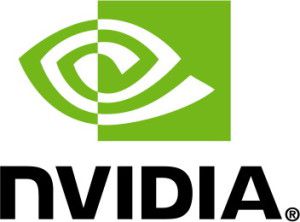
|
Speaking to GamesIndustry.biz, Roy Taylor, VP of Content Business Development, admitted that NVIDIA’s current range of products is over complicated and too confusing for many customers. Taylor went on to say the company faced a “challenge” but needed to make its products more consumer friendly.
Source: Games Industry
Published on May 8, 2008OpenOffice.org Releases 3.0 Beta, Looking Good So Far
Popular office suite OpenOffice.org has just released it’s first 3.0 public beta, and Ars Technica takes a quick look. The new version revamps the application as a whole, updating the look and feel, and essentially making it more of a competitor to Microsoft’s Office 2007. That’s helped by the fact that Office 2007 documents (.xlsx, .docx, etc) are now supported, although with somewhat poor results so far.
I have no doubts that Office 2007 document support will encourage more people to make the shift to a free office alternative. The fact that 2.4 does not is one of the few reasons I need to reboot my main machine into Windows, so having great support there would be hugely welcome, for many. The initial results are not THAT impressive, as fonts show up different sizes, alignments are a little off and other minor issues arise, but at least it’s on the right track. If it gets better from here on out, that’s all we can ask for.
So far the beta looks great, but bear in mind that it’s a beta for a reason. Bugs are evident, such as crashes, so it shouldn’t be used for real production work. Not much sucks worse than losing work in a document randomly for no reason. For those willing to take the plunge, download the beta here.
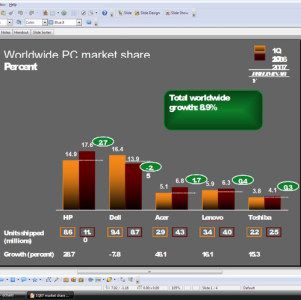
|
Enhancements have been made across the board to OpenOffice.org’s various components. A new Solver component makes calculating dependent spreadsheet cells much easier (a bonus for Mac users as Excel 2008 reportedly lost its solving component), and vastly improved cropping features in the Draw and Impress apps are indeed more intuitive. When working in Writer, multiple pages can be displayed at once for a bird’s eye view of a document, and notes (or comments) on a document are now displayed in a sidebar, paralleling the same UI found in many other text editors.
Source: Ars Technica
Published on May 8, 2008Stopping Windows from Accidentally Copying Files
As soon as I saw this new tip at the How-To Geek, I knew I had to come post about it. This is a particular issue that I’ve been annoyed by for as long as I remember using Windows. The issue is simple. You have a huge folder with many files, and you want to copy a collection of files to another folder. So, you hold down your CTRL key and start clicking away.
All is fine and good until you accidentally drag your cursor in any direction while clicking a file, which Windows takes as a request to automatically copy every single file and folder you’ve just selected. The end result is that you need to go clean up what it copied, or if you are lucky, a CTRL + Z (Undo) function might work.
While the How-To Geek doesn’t have a direct fix, they do have a work-around. The reason the files copy is because you’ve moved your cursor four pixels, which is seriously nothing. They show you how to perform a small registry hack to increase that number. Even bumping up to 15 should rid the problem from ever occurring. Even better would be an option right inside Windows to disable that “helpful” feature though.
Have you EVER wanted to copy an array of files inside the same folder you are working in? I can’t think of a single occasion that I have. It seems that helpful feature isn’t very helpful at all.
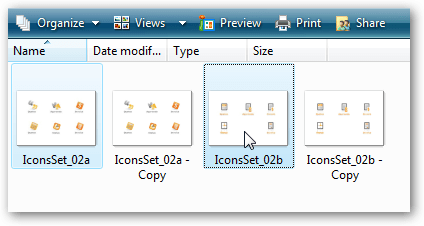
|
If you are running Windows XP, you can use Microsoft’s free Tweak UI utility to configure the drag setting easily. What we’ll do is tell Windows not to assume that we’re dragging until we’ve move more than 4 pixels, which should eliminate this problem, but still make drag and drop work fine for regular operations.
Source: How-To Geek
Published on May 7, 2008Yahoo! Up for More Negotiation with Microsoft
Who needs a television when all the drama can be found online? That’s what the Microsoft/Yahoo! debacle has been since it began, and it’s sure not losing its lustre quite yet. Over the weekend, Steve Ballmer, CEO of Microsoft, withdrew the bid to acquire Yahoo!, and I doubt many would disagree that their offer was generous at $31 a share, or a 61% premium.
But now, Yahoo! looks nothing but red in the face. Chances are good that they were not planning on Microsoft dropping out, especially with the companies adamant ‘we’re not going anywhere’ attitude. But, it happened, and now Yahoo! is feeling sick to the stomach. After all, they could have been bought for well over $40B, but now they are just sitting pretty, unsure of what’s next.
Like a heart-broken teenager, Yahoo!’s CEO Jerry Yang and company have now stated that they’d be up for more negotiation with Microsoft, and that they’d be willing to go lower than the $37 per share that they demanded. AKA: We wanted more money, but didn’t expect you to jump ship so fast. All I know is that this drama contains the perfect blend of ingredients for either a hit emo song or new series on the CW.

|
Yahoo is getting blasted by its largest shareholder, Capital Research Global Investors, one of the most respected investment institutions on Wall Street. Gordon Crawford, a portfolio manager with the firm remarked in the WSJ article, “I’m extremely disappointed in Jerry Yang, I think he overplayed a weak hand. And I’m even more disappointed in the independent directors who were not responsive to the needs of independent shareholders.”
Source: DailyTech
Published on May 7, 2008Spore and Mass Effect to Require Occasional Re-validation
Is it just me, or are game companies actually getting more clueless as the days pass? It has to be the case, because I am seeing it with my own eyes. Remember the massive uproar when BioShock shipped with SecuROM? Or how about when the company announced that the sequel would include even more hardcore copy protection?
According to Shacknews, two companies who still haven’t found that clue are Electronic Arts and BioWare, as both Spore and Mass Effect PC will feature SecuROM as well. But it’s better! Depending on what the developer sets, the game will require an Internet connection to verify with their servers in order to re-validate your serial key. You know, in case it somehow got leaked onto warez networks or torrent sites.
I am not sure how I can put this in a professional manner, so I won’t. Whoever decided on this is a complete idiot. Someone whose pupils are shaped like dollar signs. Someone who has apparently never bought a PC game themselves.
Did SecuROM help prevent BioShock from being pirated? Hardly. In fact, it was released to torrent networks before the game’s actual street date. The exact same situation occurred with Crysis. Despite its check at the game start-up for a legal CD, crackers still did their thing. Who benefits? The pirates. That’s who. Who’s inconvenienced? The legal consumer. That’s who.
One might be quick to say “who cares?”, but it’s the fact that companies continue to make things difficult on the legal consumer that’s frustrating, when it’s clear no ground is being gained in ridding piracy. Am I annoyed that I have to keep my Crysis disc near our benchmarking rigs all the time? Yes, sure. But even that beats this forthcoming method of doing things.
What about those who don’t have Internet? What happens if someone’s Internet goes down when they want to play? What happens if EA’s or BioWare’s authentication servers go down? What happens ten years down the road when those authentication servers no longer exist?
You save yourself the hassle and go download the pirated version of the game, that’s what. After all, that’s the easiest way to enjoy your legally bought games nowadays.

|
“After the first activation, SecuROM requires that [Mass Effect PC] re-check with the server within ten days (in case the CD Key has become public/warez’d and gets banned),” said French in a post on the BioWare forums. If customers do not come online after ten days, the game will cease to function. “After 10 days a re-check is required before the game can run,” added French.
Source: Shacknews
Published on May 7, 2008Why Do Xbox 360 Hard Drives Cost So Much?
Ever wonder why the Xbox 360 replacement hard drives costs so much? There’s no doubt you have if you’ve ever picked one up, since the 20GB model retails for around $90, while the 120GB is twice that. Well, would you believe that it’s because they cost that much to make? Nah, didn’t think so.
As it turns out, companies like to make money, and where they know the consumer is trapped, they jack the price high, since they know it will sell. Patrick Klepek from MTV contacted iSuppli, the company that tears into the pricing of gadgets, to see what the scoop was. As it turns out, the entire hard drive and package costs around $100 to Microsoft, but most of it is due to the retail packaging, drive enclosure and pre-bundled software (which, as far as I know, is free straight from Xbox Live).
Profit to Microsoft on their $180 drive is around $80… not bad for doing virtually nothing. The sad thing is that mobile drives, like the one used for the Xbox are cheap, so of the $100 that Microsoft pays for the drive and enclosure, less than half is likely for the drive itself. It also hurts to check out sites like NewEgg, who sell 320GB mobile drives for much less than what Microsoft charges for the Xbox 120GB drive.

|
iSuppli representative Krishna Chander expects the hard drive came from electronics manufacturers Toshiba or Seagate . When the hard drive ships to retail, it comes pre-loaded with starter software (i.e. Xbox Live Arcade trials) and “specific Gaming Instructions and some levels of the OS,” said Chander.
Source: MTV Multiplayer
Published on May 7, 2008Microsoft Re-Releases XP SP3 and Vista SP1
Last Wednesday, Microsoft pulled both SP1 for Vista and SP3 for XP due to a conflict that arose between one of their own products (how that wasn’t caught in testing is anyone’s guess). For those who were on the verge of freaking out, calm down, as they’ve thrown both service packs up and you are able to download them via normal methods.
Sadly though, the fix is not actually a fix, but a workaround. The good thing is that it will affect virtually no one, however, except those in small businesses. If for some reason you are in a situation where you have the Dynamics Retail Management System installed, a filter will block the download, so you are safe either way.
As mentioned before, there will be nothing new for home users other than bug fixes, but network administrators should be pleased with the addition of MMC 3.0 support, MSXML6, IPsec filter creation and also network access protection (NAP).
For those who prefer not to use Windows Update, you can either download an ISO or full executable.
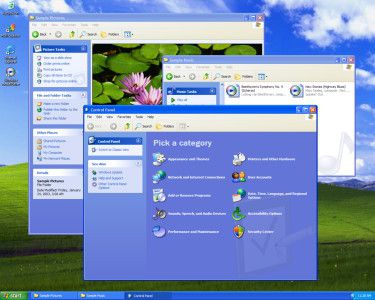
|
The software maker on Tuesday said it is releasing XP Service Pack 3 for Web downloads, and resuming automatic updates to Vista Service Pack 1, after developing a filter that will prevent machines running Dynamics RMS from getting either update. The filter is not a fix for the incompatibility, though Microsoft said it is working on that as well.
Source: Beyond Binary
Published on May 7, 2008Can AMD’s Puma Dent Intel’s Dominance in the Notebook Market?
Is anyone at this point surprised that Intel’s processors are found in the majority of notebooks on the market? Doubtful. Where the ultraportable is concerned, as the Nanotech blog points out, Intel has a huge monopoly. Of course, what else would you expect? Intel is currently churning out the most efficient chips on the market, so it makes business sense to continue shoving them in the machines.
Currently, AMD’s processors are mostly found on sub-$1,000 notebooks, which, while somewhat underpowered, tend to be feature-rich at the given price-range. But with the upcoming Puma chipset, AMD is looking to shake things up a bit, and they very well could. Puma is based on a 65nm process and enables DirectX 10, HDMI with HDCP and could even include DisplayPort.
Most notably, the new chipset opens up support for Hybrid Crossfire, which allows a separate GPU to be installed other than the integrated solution. This means lower power consumption during normal use, but better gaming performance when plugged in, since the two GPUs will essentially work together to deliver a higher average FPS.
Puma might still be a little ways off, but we’ll no doubt be seeing many notebooks utilizing the new chipset at next month’s Computex in Taiwan.

|
Puma-based notebooks will be based on the AMD Turion X2 Ultramobile processor which uses Hypertransport 3 bus for extremely fast (20.8GB/s) data transfer between CPU and chipset, power management that can turn whole segments of the chip off on a millisecond-by-millisecond basis to save power. Intel is only now catching up to AMD’s use of Hypertransport after many years, with its competing QuickPath technology, which will debut in its Nehalem-class Core 2 Duos later this year.
Source: APC Mag
Published on May 6, 2008Microsoft Continues to Deny Blu-ray Add-On
If there is one rumor that just will not die, it’s ‘Blu-ray on Xbox 360’. Rumors somehow keep on starting, and Microsoft is always quick to debunk each and every one of them. I don’t think there is any doubt that Microsoft is indeed in talks with Blu-ray drive manufacturers, but nothing seems to have been finalized so far.
As quoted at Shacknews by Microsoft, “Games are what drive consumers to purchase game consoles“, and of course, the natural inclination would be to continue focusing on that. The fact is, Blu-ray as a format is not that well known outside of the technically-savvy crowd. Anyone I know personally who actually understands what Blu-ray is, is either a tech buff or works for a retailer. Others have a hard time even knowing that Blu-ray and HD DVD are completely separate things.
Not to mention the lack of overall demand. As noted in the news last week, Blu-ray hardware sales are going up at a snail’s pace, with a 2% increase in March over February. That is horrible, given how early we are in the high-def scheme of things. Microsoft is no doubt waiting for adoption to pick up, and that will require better pricing on both Blu-ray hardware and content. It’s now all just a waiting game.
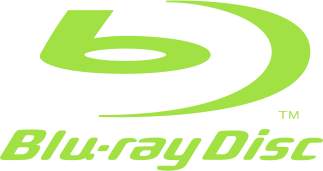
|
Much like the competing HD DVD or any other optical media, the Sony-backed Blu-ray format requires specialized equipment to operate. As Microsoft produced, and subsequently axed, an Xbox 360 add-on to enable HD DVD playback, many have speculated that the Blu-ray format will eventually make its way to the Xbox 360.
Source: Shacknews
Published on May 6, 2008OCZ Releases Ultra-Fast 2000MHz 4GB DDR3 Kit
DDR3 hasn’t been out too long – less than a year – but it’s progressed quite a bit since then. Whereas “good” 2GB kits would set you back over $500 just last summer, far superior kits can now set you back only $250, or less. Though much better, it’s still difficult for adoption to speed up when quality 2GB DDR2 kits retail for well under $100. But the fact remains, DDR3 is faster, and as a result, it’s the future (well, you know, until DDR4).
One problem up to now has been the lack of memory density in DDR3 kits. If you wanted to pick up 4GB worth, you were either going to have to remortgage your house, or suffer with lackluster performance. No more, says OCZ, with their latest Platinum kit, which surpasses the recently released DDR3-1800 Super Talent kit.
Just how fast is this 2x2GB kit? Would you believe 2000MHz? Yes, it’s fast, and to be honest, I didn’t expect to see such 2GB modules so soon. The general rule is that the higher the density and frequency, the harder it becomes to remain stable (harder being an understatement). The timings of 9-9-9-28 are highly unimpressive, but the ultra-high frequency helps make up for it. But, when realizing that the 2GB kits at those speeds use the same timings, it’s a bit easier to stomach.
Pricing is not currently known, but you can expect it to hover just over $600 once it hits the channel.

|
OCZ Platinum DDR3-2000 modules will be available in up to 4GB (2x2048MB) dual channel kits. OCZ has been working closely with the leading platform providers to ensure optimal performance and compatibility on all the next generation computing platforms.
Source: OCZ’s Product Page
Published on May 6, 2008Alles Gute zum Geburtstag! Wolfenstein 3D Turns 16
It’s a common misconception that id Software’s ‘Doom’ was the first popular 3D-shooter for the PC, but it was actually Wolfenstein 3D, a Nazi-infested game that was released a full 18 months earlier. If you grew up with a PC and happened to be a gamer, then chances are good that you’ve played it. I know I did, and at nine-years-old, I shouldn’t have (I was good at sneaking things).
Wolf 3D was the first game to actually scare me bad enough that I had to leave the room. Walking around a corner after a five-minute lull and having a Nazi shout in German at you and a rabid dog bark its yap off might do it for anyone. It was then that I knew I should have been playing Ken’s Labyrinth instead.
Thanks to Wired’s never-ending knack of remembering things, we know that the game has just turned sixteen… incredible. In reality, that’s far from being long ago, but to look at where gaming is today and looking back, the situation is nothing short of spectacular. Who would have played Wolf 3D or Doom and even thought for a second that gaming would be what it is today? If you spoke out loud about it, you may have found yourself in protective care for a while.

|
Wolfenstein 3-D may not have been the very first “first-person shooter,” as the genre came to be known, but it was by far the most successful. Technically the genre goes back to the ’70s, but no one really paid any attention to it. Even id released an earlier FPS called Catacombs 3D, but again, it wasn’t nearly as good as Wolfenstein.
Source: Wired
Published on May 6, 2008eVGA’s UV Plus+ USB Graphics Adapters Now Available
While at CES this year, eVGA surprised me when they pointed to a small square box sitting on a table. What could eVGA have to do with such a small and simple-looking product, I thought. Well, upon further inspection, it turned out to be a gadget for adding displays to your rig, which I later found out was handled by a DisplayLink USB graphics chip.
I took a deeper look at DisplayLink in February and was actually floored by how easy it was to setup. The installation was simple, and performance (non-3D) was incredible. For those who are too lazy not interested in checking out the article, the concept is simple. With the help of USB connectors, and this device, you can hook up to four additional displays, all from the same PC.
The benefits are obvious. It means you don’t need a second GPU or to open your PC at all. Or for notebook users, it means you can use multiple displays with ease. The exact device I took a look at was rather plain in style, but thankfully, eVGA had no intention of holding back. Their UV Plus+ series are gorgeous in comparison, as you can see in the below photo.
Two models will be immediately available, the UV-16 and UV-12. The former will allow up to 1680×1050 per display, while the latter will allow up to 1400×1050 or 1440×900. So far, I found NewEgg to carry the UV-16 for a reasonable $80.99 (the competition is well over $100). Now all we need is perfected Mac OS X drivers and hopefully in the near future, some Linux support.
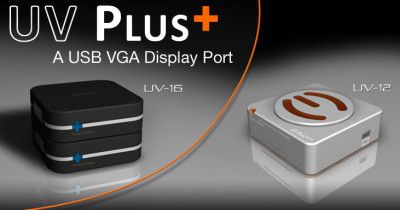
|
PALO ALTO, CALIF.–(BUSINESS WIRE)–DisplayLink and EVGA today announced that they have teamed to deliver a new generation of affordable USB graphics adapters (UGAs) for mass-market retail consumers. EVGA’s new UV Plus+ Family of products which consists of the UV12 and UV16 USB graphics adapters, are based on DisplayLink network display technology, enabling Windows XP and Vista users to quickly and easily connect multiple displays to a PC or notebook via simple USB connection.
Source: DisplayLink & eVGA Press Release
Published on May 6, 2008Super Talent Releases (Somewhat) Affordable SSD Lineup
Less than two months ago, memory manufacturer Super Talent released one of the largest solid-state disks we’ve seen to date, and at 256GB, it was undoubtedly impressive. But at $6,000, it became more exclusive than a Rolex. The fact is, SSDs started out expensive and haven’t gone down in price much at all, but Super Talent’s latest release is looking to change that.
Though not stated, their new MasterDrive series are more appropriate for end-users over their original models, as most of them are going to retail for well under $1,000. The ‘MX’ series will include three different models, 30GB, 60GB and 120GB, the latter of which is rather staggering considering many popular SSDs on the market don’t currently go beyond 64GB. Prices are $299, $449 and $699, respectively.
The reason for the lower prices is due to the use of MLC flash chips, rather than the faster SLC. So while the read speed will be on par with what we’ve seen (120MB/s), the write speed drops to around 40MB/s. The ‘DX’ series by comparison stick with SLC while boosting the write speed to 70MB/s. Is the speed boost worth the extra cost? At $699 for the 30GB and $1299 for the 60GB, that’s a question you will have to answer yourself.
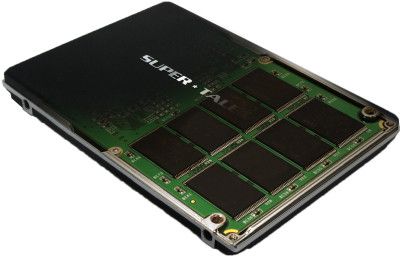
|
MasterDrive SSDs use NAND Flash rather than magnetic platters as the storage medium, giving them many advantages over HDDs. These drives have no moving parts, and therefore are completely silent, lighter weight and more reliable than HDDs. Moreover, they consume a fraction of the power of HDDs, meaning they produce less heat and offer longer battery life in mobile computing.
Source: Super Talent Press Release
Published on May 6, 2008Nine Inch Nails Release Yet Another Free Album
It’s been two months since the launch of NIN’s last album, Ghosts I-IV, but the band has wasted no time with a follow-up, entitled ‘The Slip’. While Ghosts was an instrumental album, The Slip goes back to their roots and deliver hard-hitting tracks that fans are used to.
Like Ghosts, NIN is offering The Spin free of charge… in its entirety. You can go to sign-up page to enter your e-mail address, and you will receive an e-mail with a download link. I have yet to receive mine, however, so the servers are no doubt getting pounded. It might be wise to wait until this evening to enter the address, if you think you can hold off that long.
The band stresses that the album is one hundred percent free. It’s free to pass to a friend, to a stranger, to a blog and free to remix. For those who want hard copies (like me), the album will become available in July on both CD and LP. Oddly though, despite ordering Ghosts on the launch date, I have yet to receive my hard copy.

|
the music is available in a variety of formats including high-quality MP3, FLAC or M4A lossless at CD quality and even higher-than-CD quality 24/96 WAVE. your link will include all options – all free. all downloads include a PDF with artwork and credits.
Source: NIN – The Slip
Published on May 5, 2008Amazon Sues NY State Over New Tax Rule
New York state loves taxes, who knew? Last week, the state put forth a requirement that e-tailers in other parts of the country would have to begin taxing NY-based consumers appropriately. Currently, Amazon does not tax consumers on any of the merchandise, as far as I can tell. I have looked through my previous Amazon receipts, and even being in Canada, I have never been taxed for items there. I didn’t even realize this until now.
Well, consumers are not the only ones upset with this new decision. Amazon has wasted no time in suing the state in order to void the sales tax rule. Whether they will be successful or not is anyone’s guess. One major e-tailer vs. one major city. That’s a tough one to call.
I have to wonder if things are a little different in Canada, though. While Amazon doesn’t charge me taxes, I noticed that another e-tailer based in Canada does charge tax, on par with what I’d have to pay if I walked into a store. They base it off of whatever province you are in, and adjust the sale accordingly. Whether this e-tailer even has to do this, I’m unsure, since Amazon seems to get away without charging any tax at all.
If Amazon fails to succeed at this lawsuit, then it could mean bad things for online shoppers. If New York is successful, there’s nothing stopping other states from joining on in.

|
The new law is based on a novel definition of what constitutes a presence in the state: It includes any Web site based in the state that earns a referral fee for sending customers to an online retailer. Amazon has hundreds of thousands of affiliates—from big publishers to tiny blogs—that feature links to its products. It says thousands of those have given an address in New York State, although it does not verify the addresses.
Source: New York Times
Published on May 5, 2008Ubuntu 8.04 is Well Worth the Look
The latest Ubuntu release came out just two weeks ago, but that’s old news by now. I have never been much of an Ubuntu fan, and the fact is, I disliked it… a lot. I still stand by the fact that I believe the distro was severely over hyped with the earlier versions, but the latest launch, “Hardy Heron” changes my thoughts quite a bit.
New Ubuntu versions come out often, but this one is different. It offers “Long-Term Support”, so you can install it and not have to worry about support fading before three-years pass. From my previous experience with Feisty Fawn, however, Hardy Heron is far more polished and is putting Linux on the right track to mass adoption.
Booting up on the notebook, everything worked, from the graphics to WiFi to audio to Bluetooth to web cam and beyond. I couldn’t find anything that didn’t work. And that was before the installation! So to say I’m impressed would be an understatement. I use Gentoo on the desktop and have zero interest of using Ubuntu there given I prefer how that distro works, but for the notebook, it’s absolutely perfect. The less work you need to do in the initial setup process, the better.
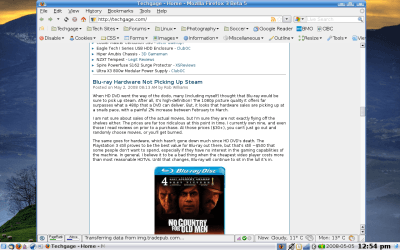
|
I am not a fan of GNOME, however, so I tested out both Ubuntu and Kubuntu, and ultimately stuck with the latter. It’s hard to not notice the difference between the two, though. While hardware detection is the same, Kubuntu lacks the overall polish of Ubuntu, which is fine by me since I tend to configure things a lot anyway, but it’s still too bad. There’s not even a GRUB bootsplash like there is for Ubuntu, which is beyond strange given how simple it is to add.
But that aside, I’m pleased so far with Kubuntu and have no real complaints. It lacks certain things that I like, but that’s because I’m so used to my current setup. Ubuntu is catered towards new users and veterans alike, so it’s design can’t be faulted too much (although there are a few things I do find strange, but I’ll tackle that later). Overall though, this is the first time I’ve ever recommended Ubuntu, so I’m off to go pinch myself.
Source: Ubuntu
Published on May 5, 2008NVIDIA’s David Kirk Discusses CUDA, CPUs & GPUs
It’s unlikely that many would disagree that parallel computing is in the future, and if you ask NVIDIA’s David Kirk, it’s best done on a GPU. Bit-Tech’s Tim Smalley sat down with Kirk, NVIDIA’s Chief Scientist, for a lengthy chat discussing everything from parallel computing with CUDA to Intel’s Ct to ray tracing and rasterization and oh so much more. There is little ground not covered, so a coffee refill would make sense before reading.
CUDA is NVIDIA’s answer to parallel computing, allowing developers to write code in C designed for special purposes that would execute much faster on a GPU than on a multi-core CPU. Kirk mentions in the article that certain tasks would just not be feasible on a CPU, and when speaking of offloading GPU processes to a CPU, he mentions that “it would be at least a thousand times too slow“. Well then, can’t get a more straight-forward answer than that.
He also has no issue with commenting on the competitors, and some of the responses are quotable, such as, “Their market cap is about three billion, so it’s hard to see where the future is in that picture. Really speaking, they’re going to have to pull not one, but several rabbits out of the hat.” when speaking about AMD. Harsh, but it’s difficult to disagree at this point. Don’t worry, Intel feels the wrath as well, with “Building a CPU is not that hard”.
I am pointing out the humorous bits, but the article as a whole is informative if you want to brush up on where CUDA stands, why it exists, and what’s in store for the future.

|
“The biggest problem ahead for GPUs is that they are designed to be multi-core and we’ve made all of the mistakes before,” David explained, while laughing. “OK, maybe not all of them – but we’ve learned a bunch of things over the years through the course of building massively parallel GPUs.
Source: Bit-Tech
Published on May 5, 2008Microsoft Withdrawals Bid for Yahoo!
After almost three months of constant bartering with Yahoo!, Microsoft has withdrawn their bid for the company. Microsoft’s last offer sat at $47.5 billion, or $33 per share, while Yahoo! refused to accept anything lower than $37 per share. It was not in Microsoft’s best interest to go higher, which Ballmer addressed over the weekend.
Despite the withdrawal, Ballmer believes that the final bid was more than fair, and many others agree as well. All except Yahoo!, of course. For the past couple years, Yahoo! has not been doing well at turning traffic into profit, which is one of the reasons they are willing to be bought up by someone. However, since Microsoft’s initial bid, CEO Jerry Yang has kept adamant about the fact that the company is on the rise, and not vice versa.
Regardless of that, today is going to be an incredibly interesting day for Yang, as many shareholders are not expected to stick around after the news of Microsoft’s withdrawal. Once the “aftermath” settles, Yahoo!’s market value is expected to plummet to $30 billion, down from the ~$40 billion it sits at now.
Microsoft’s withdrawal doesn’t mean the fun stops now, however. Some speculate that Microsoft could consider a re-bid if Yahoo! continues to go downward, but at this point, it’s hard to guess what could happen.

|
Analysts now expect Ballmer to use the money he had earmarked for the Yahoo acquisition to explore other possible deals with large Internet companies like Time Warner Inc.’s AOL and News Corp.’s MySpace and promising startups like Facebook Inc. and LinkedIn Corp. Microsoft already owns a 1.6 percent in Facebook, the second-largest social network behind MySpace.
Source: Yahoo!
Published on May 5, 2008ASUS EN9600GT Silent 512MB
Looking for excellent gaming performance but also want to keep PC noise to a minimum? The EN9600GT Silent from ASUS is the card to buy. It couples the power of the 9600 GT with pure silence, and costs little more than the stock model, making it a great choice for either the HTPC or desktop.
Published on May 5, 2008GTA IV What? Iron Man Scores $100.8 Million at the Box Office Over the Weekend
Over the course of the past month, it was speculated by many sources that the theatrical release of Iron Man could potentially see lackluster sales thanks to Grand Theft Auto IV’s release earlier in the week. Could a game actually keep people home, who would otherwise want to see the flick? Not according to the weekend box office sales reports, which put the film at a staggering $100.8 million, far ahead of the $15 million that the movie to take the second spot scored.
This result isn’t too interesting, however. Are there really that many people, who after playing a game for days on end, wouldn’t take a three hour break to go see a new movie that they’ve been waiting for? I can see it for some, but I can’t see it for the majority, and I guess the sales numbers back up those claims. If someone is that worried about the game not being there once back home, they could just as easy take it with them to the theatre.
I saw Iron Man last night and highly recommend it to anyone, Iron Man fan or not. It’s been a while since I’ve enjoyed a superhero movie, but this one was executed perfectly. I’m sure glad I took a break from the game to see it. Oh wait… I still haven’t opened it, that’s right. Where are my sense of priorities…

|
Iron Man crushed its competitors this weekend with a stunning estimate of $100.8M in ticket sales over the Friday-to-Sunday period delivering the tenth largest opening of all-time and the second highest ever for a non-sequel after the $114.8M of 2002’s Marvel Comics sibling Spider-Man. The Robert Downey Jr. flick began its run on Thursday at 8pm with advance showtimes grossing $3.5M in the four-hour period ending at midnight, the official start of Friday.
Source: Rotten Tomatoes
Published on May 5, 2008Older Entries
Newer Entries
Copyright © 2005-2025 Techgage Networks - All Rights Reserved.
About Us | Advertise | Terms & Conditions | Privacy Policy




